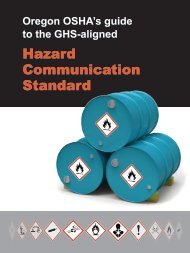Technical Manual - Section 3 (Safety Hazards)
Technical Manual - Section 3 (Safety Hazards)
Technical Manual - Section 3 (Safety Hazards)
You also want an ePaper? Increase the reach of your titles
YUMPU automatically turns print PDFs into web optimized ePapers that Google loves.
Treating can be accomplished at an intermediate stage in the<br />
refining process, or just before sending the finished product<br />
to storage. Choices of a treating method depend on the nature<br />
of the petroleum fractions, amount and type of impurities in<br />
the fractions to be treated, the extent to which the process<br />
removes the impurities, and end-product specifications.<br />
Treating materials include acids, solvents, alkalis, oxidizing,<br />
and adsorption agents.<br />
ACID, CAUSTIC, OR CLAY TREATING<br />
Sulfuric acid is the most commonly used acid treating<br />
process. Sulfuric acid treating results in partial or complete<br />
removal of unsaturated hydrocarbons, sulfur, nitrogen, and<br />
oxygen compounds, and resinous and asphaltic compounds.<br />
It is used to improve the odor, color, stability, carbon residue,<br />
and other properties of the oil. Clay/lime treatment of<br />
acid-refined oil removes traces of asphaltic materials and<br />
other compounds improving product color, odor, and<br />
stability. Caustic treating with sodium (or potassium)<br />
hydroxide is used to improve odor and color by removing<br />
organic acids (naphthenic acids, phenols) and sulfur<br />
compounds (mercaptans, H2S) by a caustic wash. By<br />
combining caustic soda solution with various solubility<br />
promoters (e.g., methyl alcohol and cresols), up to 99% of all<br />
mercaptans as well as oxygen and nitrogen compounds can be<br />
dissolved from petroleum fractions.<br />
DRYING AND SWEETENING<br />
Feedstocks from various refinery units are sent to gas treating<br />
plants where butanes and butenes are removed for use as<br />
alkylation feedstock, heavier components are sent to gasoline<br />
blending, propane is recovered for LPG, and propylene is<br />
removed for use in petrochemicals. Some mercaptans are<br />
removed by water-soluble chemicals that react with the<br />
mercaptans. Caustic liquid (sodium hydroxide), amine<br />
compounds (diethanolamine) or fixed-bed catalyst sweetening<br />
also may be used. Drying is accomplished by the use of water<br />
absorption or adsorption agents to remove water from the<br />
products. Some processes simultaneously dry and sweeten by<br />
adsorption on molecular sieves.<br />
SULFUR RECOVERY<br />
Sulfur recovery converts hydrogen sulfide in sour gases and<br />
hydrocarbon streams to elemental sulfur. The most widely<br />
used recovery system is the Claus process, which uses both<br />
thermal and catalytic-conversion reactions. A typical process<br />
produces elemental sulfur by burning hydrogen sulfide under<br />
controlled conditions. Knockout pots are used to remove<br />
water and hydrocarbons from feed gas streams. The gases are<br />
then exposed to a catalyst to recover additional sulfur. Sulfur<br />
vapor from burning and conversion is condensed and<br />
recovered.<br />
HYDROGEN SULFIDE SCRUBBING<br />
Hydrogen sulfide scrubbing is a common treating process in<br />
which the hydrocarbon feedstock is first scrubbed to prevent<br />
catalyst poisoning. Depending on the feedstock and the<br />
nature of contaminants, desulfurization methods vary from<br />
ambient temperature-activated charcoal absorption to<br />
high-temperature catalytic hydrogenation followed by zinc<br />
oxide treating.<br />
Table III:2-18 SWEETENING AND TREATING PROCESSES<br />
Feedstocks From Process Products........................To<br />
Gases Various Treatment Butane & butene..............Alkylation<br />
Finished products<br />
Propane, distillates...........Storage<br />
Intermediates<br />
Gasoline........................Blending<br />
Propylene......................Petrochemical<br />
III:2-42
















